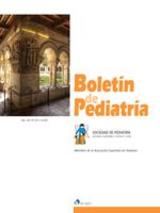Estudio del impacto de la pandemia por COVID-19 en las Urgencias Pediátricas de un hospital de tercer nivel
M.L. Álvarez Fernández , B. Álvarez Juan , A. Tamargo Cuervo , I. Robles Álvarez , I. Valdés Montejo , A.G. Andrés Andrés , R. Velasco Zúñiga
Bol. Pediatr. 2021; 61 (257): 166 - 173
Introducción. En los últimos años, los servicios de urgencias hospitalarias han experimentado un aumento progresivo de la demanda asistencial, a expensas de patología banal. Esta tendencia cambia a partir del 14 de marzo, cuando se decreta el estado de alarma debido a la pandemia por COVID-19, lo que supone el confinamiento obligatorio poblacional. Objetivos. Determinar el impacto que este estado de alarma ha tenido en el volumen de las urgencias pediátricas de un hospital de tercer nivel. Material y métodos. Se ha realizado un estudio retrospectivo de cohortes y se han incluido los menores de 14 años que demandaron asistencia durante los meses del estado de alarma y durante los mismos meses en el año anterior. Se han analizado diferentes datos epidemiológicos y clínicos. Resultados. 3.371 pacientes acudieron a nuestro Servicio de Urgencias en 2019 y 650 lo hicieron en 2020, siendo la media de edad de los pacientes similar. Los grupos diagnósticos al alta más frecuentes en ambos periodos de tiempo fueron las patologías infecciosa y digestiva. En cuanto a los ingresos hospitalarios, en 2019 requirieron ingreso el 7,12%, y en 2020, el 13,69%. Respecto al servicio a cargo del paciente durante el ingreso, destaca que en 2020 el 27,72% lo hizo a cargo de Cirugía Pediátrica. Conclusiones. La actividad en las Urgencias Pediátricas de nuestro hospital ha variado notablemente durante el estado de alarma. Se ha producido una disminución considerable del número de pacientes que han demandado asistencia debido a la percepción de riesgo de contagio por parte de la población. Además, hemos percibido un aumento relativo de los ingresos hospitalarios y, en concreto, en la patología quirúrgica urgente con respecto al año anterior.
Study on the impact of COVID-19 pandemic on pediatric emergencies of a third level hospital
Objectives. In recent years, hospital emergency departments have experienced a progressive increase in the demand for care, at the expense of trivial pathology. This trend changes from 14 March 2020, when the state of alarm was declared due to the COVID-19 pandemic, which led to the compulsory confinement of the population. The main objective of this study was to determine the impact that this state of alarm has had on the volume of paediatric emergencies in a third level hospital.
Material and methods. A retrospective study of cohorts was carried out and included those under 14 years of age who demanded care during the months of the state of alarm and during the same months in the previous year. Different epidemiological and clinical data have been analysed.
Results. 3,371 patients attended our Emergency Department in 2019, and 650 in 2020, with a similar average patient age. The most frequent diagnostic groups at discharge in both time periods were infectious and digestive diseases. In terms of hospital admissions, 7.12% required admission in 2019 and 13.69% in 2020. Regarding the department in charge of the patient during admission, in 2020 27.72% of patients were admitted by Paediatric Surgery.
Conclusions. The activity in the paediatric emergency departments of our hospital varied considerably during the state of alarm. There has been a considerable decrease in the number of patients who have requested assistance due to the perceived risk of contagion by the population. In addition, we have perceived a relative increase in hospital admissions and, specifically, in urgent surgical pathology compared to the previous year
Artículo completo (PDF) (136 kb.)
- Urgencias/UCIP
Buscar en el boletín
Año 2021, Volumen 61, Número 257

Boletín completo en PDF (847 kb.)